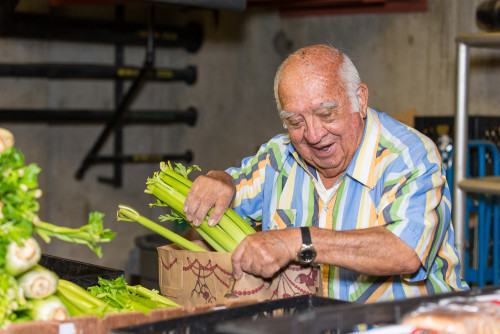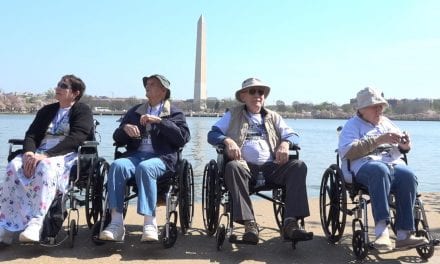For the volunteers and recipients alike it provides a reason to live and thrive.
Over the last several months I have had the chance to get acquainted with Jesse Jantzen and Adriene Iverson the leadership team at Elder Care Alliance, a San Francisco Bay Area not-for-profit. Over lunch they told me about the Mercy Brown Bag Program that operates out of their Oakland community Mercy Retirement & Care Center. Mercy is more than 100 years old and provides independent living, assisted living, memory care and skilled nursing.
Mercy Brown Bag
Jesse and Adriene introduced me to Krista Lucchesi, director of the Mercy Brown Bag Program. I just had to go visit. This is what I learned. The Mercy Retirement & Care Center is located in a chronically under privileged neighborhood of Oakland. The neighborhood includes many seniors who. living on their own, find it tough to make their limited income cover food costs for the entire month.
More than 30 years ago some of the residents, all of whom had enough to eat each month, took a hard look at their community, saw this critical need and determined to do something about it. They solicited donations of food and started passing out brown bags of groceries to the elderly needy in their neighborhood.
At some point, Mercy applied to be the distributing organization to deliver groceries to low income seniors in Alameda County under a program called Brown Bag. While the funding for that program no longer exists, the program lives on through grants, donations, and in-kind support.
Today
The program today is much larger and stronger than it has ever been, and the need is growing. They currently distribute more than 1,000 bags per week and it looks like this:
- Some original volunteers who started the program are still alive and residing at Mercy (well into their 90’s). Giving testament to the idea that having a purpose improves longevity.
- Households receive groceries 2 times per month, including fresh produce, protein, bread, canned and dry goods.
- They serve 4,600 individuals in 3,000 households each month.
- There are 15 distribution centers that distribute 20+ pounds of groceries to individuals and more than 50 senior service providers, such as Meals on Wheels, low-income senior apartments, or adult day care centers.
- To be eligible to receive these bags individuals must:
o Be age 60+
o Low Income (125% of poverty level)
o Live in Alameda County
- Their operating model is “Seniors Helping Seniors”. To this end there are 500 senior volunteers who donate 20,000+ in-kind hours per year to make this happen. The beauty of this is that the recipients don’t view it as a handout. In fact, it is their vocation.
Life Giving, Life Affirming
While it is obvious that providing these bags of food makes a huge difference in the community the program serves, providing seriously needed supplemental food for seniors, this program is much more important than that.
For the volunteers and recipients alike it provides a reason to live and thrive. For many of the seniors, both volunteers and recipients, this program represents their most significant episodes of socialization each month.
In our industry we have largely adopted a cruise ship / luxury hotel motif. I get that this is a much easier thing to sell to residents and families than a sales pitch that says, “pay us a lot of money each month so we can put you to work.”
But, honestly, we need to rethink this.
The right kinds of work, the right amounts of work, that improves the lives of others becomes life giving to seniors. If we could grasp this concept we would see healthier residents and long lengths of stays.
I am convinced we would see seniors moving into our communities at a younger age. Last week I had a chance to visit with someone who is new to senior living and is planning a CCRC that will address these fundamental human needs for seniors. I don’t have permission to write about it yet, but I hope when I do write about it, you will be as excited as I am.
Steve



![The Joy of Aging [Part 3 of 3]](https://www.seniorlivingforesight.net/wp-content/uploads/2022/11/128605049_m-440x264.jpg)





Penney Retirement Community, a CCRC in Northeast Florida, has also proven that purposeful living leads to healthier, happier, longer-living seniors. Maintaining the legacy of J.C. Penney when he established the community in 1926, our residents gave more than 125,000 hours of their time and talents last year. The serve both fellow residents and the surrounding area. There are more than 80 clubs and organizations on campus they can choose from — anything from serving on the Board of Directors, assisting in the memory-care home, serving as guardians ad litem in the County and much, much more.
Steve,
this is actually a topic near & dear to my heart. I’ve taken this same concept of ‘the positivity of ‘giving back’ to my professional Dementia Care provider clients. Same idea – that we must find ways for our friends with Dementia to remain connected to their communities by creating ‘volunteer’ ops – that support their remanining capabilities. I’m actually presenting this topic to the October NADSA Conf. in Charlotte: ‘Volunteerism. Purposeful Engagements for our Friends with Dementia’. In addition, I’ve written about this topic: http://keepinmindinc.com/dementia-dignity-consider-volunteering/
Throughout my own career- I’ve had marvelous success and outcomes – developing volunteer projects for the seniors I served. It’s a win-win for both sides of the equation. And, it shatters the stigma – of folks thinking that once they get a Dementia diagonisis, they must sit in a dark corner and wilt away. Maintaining purposeful contact with their community and society – reinforces all the remaining capabilities and contributions that still remain. Thanks for sharing this story!!!